Pictures of Moses as a Baby and as Pharoh's Son
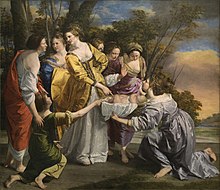
The Finding of Moses, sometimes called Moses in the Bullrushes, Moses Saved from the Waters,[1] or other variants, is the story in chapter 2 of the Book of Exodus in the Hebrew Bible of the finding in the River Nile of Moses equally a baby past the daughter of Pharaoh. The story became a common subject in fine art, especially from the Renaissance onwards.
Depictions in Jewish and Islamic art are much less frequent, but some Christian depictions show details derived from extra-biblical Jewish texts. The earliest surviving delineation in art is a fresco in the Dura-Europos synagogue, datable to around 244 AD, whose motif of a "naked princess" bathing in the river has been related to much after art. A contrasting tradition, starting time in the Renaissance, gave neat attention to the rich costumes of the princess and her retinue.
Moses was a central figure in Jewish tradition, and was given a diverseness of different significances in Christian thought. He was regarded as a typological precursor of Christ, but could at times also be regarded every bit a precursor or allegorical representation of things equally various as the pope, Venice, the Dutch Republic, or Louis Xiv. The subject area as well represented a case of a foundling or abased child, a significant social issue into mod times.

Biblical account [edit]
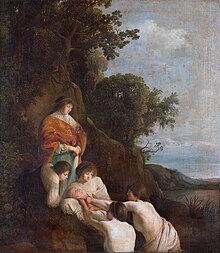
Chapter 1:xv–22 of the Book of Exodus recounts how during the captivity in Egypt of the Jewish people, the Pharaoh ordered: "Every Hebrew boy that is born you must throw into the Nile, merely let every girl live." Chapter two begins with the birth of Moses, and continues:
When she [Moses' mother] saw that he was a fine child, she hid him for three months. 3 But when she could hide him no longer, she got a papyrus basket for him and coated it with tar and pitch. So she placed the kid in it and put it among the reeds along the bank of the Nile. 4 His sister [Miriam] stood at a distance to encounter what would happen to him.
5 Then Pharaoh'due south daughter went down to the Nile to bathe, and her attendants were walking along the riverbank. She saw the basket among the reeds and sent her female slave to go it. six She opened it and saw the baby. He was crying, and she felt sorry for him. "This is one of the Hebrew babies", she said. 7 Then his sister asked Pharaoh's daughter, "Shall I become and go one of the Hebrew women to nurse the baby for you?"
8 "Yes, go," she answered. So the girl went and got the baby'due south mother. 9 Pharaoh'due south girl said to her, "Take this baby and nurse him for me, and I will pay you." So the woman took the baby and nursed him. x When the kid grew older, she took him to Pharaoh'due south daughter and he became her son. She named him Moses, saying, "I drew him out of the water."[two]
Visualizing the biblical account [edit]
The biblical account allows for a diverseness of compositions. There are several different moments in the story, which are quite frequently compressed or combined in depictions, and the moment shown, and even the identity of the figures, is often unclear. In detail, Miriam and Moses'southward mother, traditionally given the name Jochabed, may be thought to be included in the group effectually the princess.[three]
The Hebrew give-and-take usually translated equally "basket" in verse 3 tin also mean "ark", or minor boat.[four] Both vessels announced in art, the ark in fact represented as though made of stiff sheets like solid forest,[5] rather than the ark of bulrushes preferred in contempo religious traditions. The basket, unremarkably with a rounded shape, is more common in Christian art (at least in the Western Church), and the ark more then in Jewish and Byzantine art; it is also used in the Islamic miniature described below.[6] In all traditions most depictions show a stretch of open river with few reeds, and the vessel is sometimes seen drifting along in the flow. Exceptions are many 19th-century depictions, and some in late medieval manuscripts of the Bible Moralisée type.

The Exposition of Moses, as his female parent casts him off. The princess'south party is further downward the bank. Nicolas Poussin
The less common preceding scene of Moses being left in the reeds is formally called The Exposition of Moses .[7] In some depictions this is shown in the altitude as a subsidiary scene, and some cycles, by and large illustrating books, show both scenes. In some cases information technology may be difficult to distinguish betwixt the two; usually the Exposition includes Moses' female parent and sis, and sometimes his begetter and other figures.
Rivka Ulmer identifies recurrent "bug" in the iconography of the subject:[8]
- Is Moses in an ark or basket?
- The type of manus gesture of Pharaoh's daughter;
- Who enters the Nile to fetch Moses?
- The number and the gender of the "handmaids";
- What function, if any, is assigned to the River Nile?
- The presence or absenteeism of Egyptian artifacts.
Christian art [edit]
Medieval [edit]

Medieval depictions are sometimes plant in illuminated manuscripts and other media. The incident was regarded as a typological precursor of the Proclamation, and sometimes paired with information technology. This probably accounts for it being represented equally a faded fresco on the rear wall in the Annunciation by Jan van Eyck in the National Gallery of Art, Washington.[9] It might too be regarded every bit prefiguring "the reception of Christ by the community of the true-blue",[x] the Resurrection of Jesus, and the escape from the Massacre of the Innocents by the Flight into Arab republic of egypt.[xi] The princess was often seen allegorically as representing the Church, or earlier the Gentile Church.[12] Alternatively, Moses might exist a blazon for Saint Peter, and then by extension the Pope or Papacy.[13]
Cycles with the life of Moses were not common, merely where they exist they may begin with this subject if they accept more about four scenes.[14] The 4th-century Brescia Casket includes it among its 4 or 5 relief scenes from the Life of Moses, and there is idea to take been a delineation (now lost) in the mosaics of Santa Maria Maggiore. There is a 12th-century wheel in stained drinking glass in the Basilica of Saint-Denis which includes it. Cycles are most often paired with 1 of the Life of Christ, equally later in the Sistine Chapel, where the scheme of paired cycles was intended to evoke the oldest Christian art.[15] There are several short cycles in luxury manuscripts of the Bible Moralisée and related types, some of which requite the story more than one paradigm.[16]
The depiction in the twelfth-century English Eadwine Psalter has a naked female person swimmer in the water, belongings the empty ark with i hand, while a clothed female with her anxiety in the h2o holds out the baby to the princess, who reclines on a bed or litter. This is part of some 11 scenes of the life of Moses.[17] This may relate to the Jewish visual traditions covered below.[18]
The artist of a French Romanesque capital has enjoyed himself showing the infant Moses threatened by crocodiles and perhaps hippos, equally ofttimes shown in classical depictions of the Nile landscape. This very rare handling in fact anticipates modern Biblical criticism: "The cameo of the birth of Moses does not fit the reality of the Nile, where crocodiles would make it unsafe to send a babe in a basket onto the water or fifty-fifty to bathe by the shore: even if the poor were forced to take the risk, no princess would".[19]
-
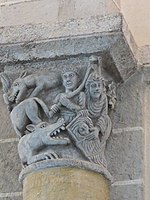
-

-

Moses being "exposed", very much in an "ark", 15th-century miniature
-

The casting-off in the foreground, combined with the finding at rear, 15th-century.
Renaissance onwards [edit]

The walls of the Sistine Chapel had facing paired cycles of the lives of Christ and Moses in large frescos, and a Finding past Pietro Perugino began the Moses sequence on the chantry wall until it was destroyed in the 1530s to make infinite for The Terminal Judgment past Michelangelo, forth with a Nativity of Jesus. Perugino'south Moses Leaving for Egypt now begins the bike.[20]
Independent pictures of the subject area became increasingly popular in the Renaissance and Bizarre periods, when the combination of several elegantly dressed and graceful ladies with a waterside mural or classical architectural background made information technology bonny to artists and patrons.[21] For Venice the story had a special resonance with the early on history of the city.[22] These paintings were for homes and palaces, sometimes for foundling hospitals.

In addition, child abandonment remained a significant social upshot in the menstruum, with foundling hospitals, orphanages specifically for abased children, a common focus of charitable activity by the rich.[23] The seal of the London Foundling Hospital showed the scene, and the creative person Francis Hayman gave them his painting of the field of study, where it hung next to William Hogarth'south painting of a slightly later on episode of the young Moses and the princess.[24] Nosotros know a depiction by Charles de La Fosse was ane of a pair of biblical subjects commissioned in 1701 for the billiards room at the Palace of Versailles, paired with Eliezer and Rebecca;[25] possibly the idea was to encourage those winning bets on the game to give their winnings to charity.
The 17th century saw the height of popularity for the subject area, with Poussin painting it at least 3 times,[26] besides as a number of versions of The Exposition of Moses.[27] It has been suggested that the birth in 1638 of the future Louis Xiv, whose parents had been childless for 23 years, may have been a factor in the interest of French artists. The poet Antoine Girard de Saint-Amant wrote an epic poem, Moyse sauvé between about 1638 and 1653.[28]

As well as the Catholic countries, in that location were also a number of versions in Dutch Gilt Age painting, where the One-time Testament field of study was considered unobjectionable, orphanages were run by boards of "regents" drawn from the local wealthy, and the story of Moses was also given contemporary political significance.[29] A painting of the subject shown on the wall behind The Astronomer by Vermeer may represent cognition and science, every bit Moses was "learned in all the wisdom of the Egyptians".[30]
A painting by Bonifazio de' Pitati of 1545 was mayhap the first large and elaborate treatment of the subject to concentrate on a larger courtly group, entirely using advisedly depicted contemporary costumes; he painted at least one smaller similar version of the discipline.[31] Bonifazio painted a number of biblical subjects as "modern aloof reality", which was already an established pictorial style in Venice.[32] This is essentially a large aloof picnic, consummate with musicians, dwarves, many dogs and a monkey, and strolling lovers, where the baby represents an object of polite curiosity.[33] A Niccolò dell'Abbate from c. 1570, at present in the Louvre, represents a more than classical handling, with the same "classical" costumes and atmosphere every bit his mythological subjects. This is closely followed by a number of compositions past Veronese, using the modern apparel of his day.[34]

The paintings of Veronese and others, particularly Venetians,[five] offered some of the attractions of subjects from pagan mythology, only with a bailiwick with a Christian context. Veronese had been chosen before the Inquisition in 1573 for his indecorous depiction of the Last Supper as an extravagant festivity mainly in modernistic wearing apparel, in what he renamed The Feast in the Firm of Levi. Since the Finding certainly called for a party of lavishly dressed court ladies and their attendants, it avoided such objections.[35]
Veronese's costumes, contemporary when he painted them in the 1570s and 1580s, became established as a sort of standard, and were copied and repeated in new compositions by a number of Venetian painters in the 18th century, during a "Veronese revival".[36] The famous painting by Giovanni Battista Tiepolo in the National Gallery of Scotland dates from the 1730s or 1740s, but avoids the fashion of that catamenia and bases its costumes on a Veronese now in Dresden, but in Venice until 1747;[37] some other Tiepolo now in the National Gallery of Victoria uses the style of Veronese even more thoroughly.[38]

Nicolas Poussin was attracted both to subjects from the life of Moses and history subjects with an Egyptian setting.[39] His figures wore the 17th-century idea of ancient clothes, and the cityscapes in the distant groundwork include pyramids and obelisks, where previously near artists, for example, Veronese, had not attempted to represent a specifically Egyptian setting.[40] An exception is Niccolò dell'Abbate, whose broadly painted cityscape include several prominent triangular elements, although some might be gable-ends. Palm trees are as well sometimes seen; European artists, even in the north, had been used to depicting these from painting the "Phenomenon of the Palm" on the Flying into Egypt in item.
For skilful mensurate the primary iii versions by Poussin all include a Roman-fashion Nilus, the god or personification of the Nile, reclining with a cornucopia, in two of them in company with a sphinx,[41] which follows a specific classical statue in the Vatican.[42] His 1647 version for the banker Pointel (now Louvre) includes a hippopotamus hunt on the river in the background, adapted from the Roman Nile mosaic of Palestrina.[43] In a give-and-take at the Académie royale de peinture et de sculpture in 1688, the painting was criticised for ii breaches of artistic decorum: the princess' pare was too dark, and the infidel god was inappropriate in a biblical subject area. Both details were corrected in a version in tapestry, though the sphinx survived.[44] Poussin'southward treatments prove sensation of much of the scholarly interest in Moses in terms of what we now telephone call comparative religion.[45]
Thereafter attempts at an authentic Egyptian setting were spasmodic, until the start of the 19th century, with the advent of modern Egyptology, and in fine art the development of Orientalism. By the late 19th-century exotic decor was often dominant, and several depictions concentrated on the ladies of the court, naked but for carefully researched jewellery. The reed beds in the Bible are often given prominence.[46] The extensive history of the scene in the movie house began in 1905, the yr after Sir Lawrence Alma-Tadema finished his painting, with the Finding the opening scene in a 5-minute biographical film by the French company Pathé.[47]
- Orientalist depictions
-

-
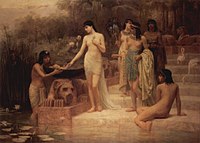
-

-

-
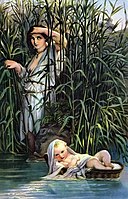
A painting by Paul Delaroche, before 1857, was much reproduced in prints and book illustrations
Jewish fine art and traditions [edit]

The earliest visual delineation of the Finding is a fresco in the Dura-Europos synagogue, datable to around 244, a unique large-calibration survival of what may have been a large body of figurative Jewish religious art in the Hellenized Roman imperial menstruation.[48] This part of a blended image shows several episodes from the childhood of Moses (only the left finish illustrated hither) and displays both Midrashic details in the narrative and visual borrowings from the iconography of classical paganism.[49] 6 of the 26 frescos in the synagogue have Moses equally their main subject.[l] There are a few illustrations in much later medieval Jewish illuminated manuscripts, mostly of the Haggadah, some of which seem to share an iconographical tradition going back to Late Antiquity.[51]
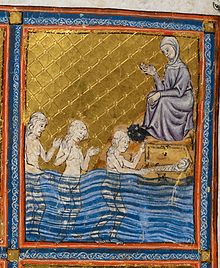
Jewish textual traditions elaborate on the text in Exodus in various ways, and it has been argued that some of these details tin be detected in Christian too as Jewish art. One Jewish tradition was that Pharaoh'south girl, identified as Bithiah, was a leper, who was bathing in the river to cleanse herself, seen as a ritual purification for which she would be naked. As at Dura-Europos, Jewish depictions often include her, and sometimes other women, standing naked in the river.[52] According to Rabbinic tradition, equally soon equally the princess touched the ark conveying Moses she was healed.[53]
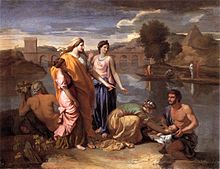
The primeval surviving Christian delineation is a fresco of the 4th century in the Catacomb of Via Latina, Rome. Iv figures are on the banking company, with Moses even so in the water; the largest is the princess, who stretches out her arms, which the baby also does. This gesture may derive from a textual variation plant in Midrashic sources and the Aramaic translation of the Bible. In these "she ... sent her female person slave" is inverse to "she stretched out her arm".[54] Though the context is Christian, many of the images here are of Onetime Testament subjects,[55] and very likely reflect models adopted from an initially Jewish visual tradition, perhaps painted by artisans with sets of models for all religious requirements. In the play Exagōgē by Ezekiel the Tragedian (3rd century BC), Moses recounts his finding, saying of the princess "And straightway seeing me, she took me upward", which may exist reflected both in the New Testament Acts 7:20, and in artistic depictions where the princess is manifestly first to grasp the ark.[56]
The motif of the naked princess standing in the water, sometimes accompanied by naked maids, reappears in Jewish manuscript illuminations from Spanish workshops in the late Middle Ages, forth with another details of iconography found in the Dura-Europos synagogue.[57] In the 14th-century Gold Haggadah there are three, while Moses' sister Miriam sits on the bank watching them.[58] Other works include the then-called "Sister of the Aureate Haggadah" manuscript, and the (Christian) Pamplona Bibles.[59] Past contrast, the 18th-century Venice Haggadah has been influenced by local Christian depictions, and shows a clothed princess on land.[sixty]
A unlike tradition is first found in Josephus, who was read by Poussin and influenced his treatment of this and other biblical scenes. His account of the finding has the princess "playing by the river bank" and spotting Moses being "borne down the stream". She "sent off some swimmers" to fetch him. Thus in Poussin's 1638 Finding in the Louvre a burly male emerges from the h2o with the child and handbasket, a detail sometimes copied by other painters.[61] This is followed in Sebastian Bourdon's painting of 1650, with two male swimmers.[62] Italian paintings more often show female swimmers, or at least females who take landed and are drying themselves afterwards handing the babe to the princess, as in Sebastiano Ricci, Salvator Rosa, Giovanni Francesco Romanelli, likewise every bit a painting in the Rijksmuseum by Paulus Bor and Cornelis Hendriksz Vroom from the 1630s, and Poussin'southward 1651 limerick. The only painting of the bailiwick from Rembrandt's studio shows several naked women who take apparently just come up out of the h2o, bringing the basket.[63]
Islamic art [edit]
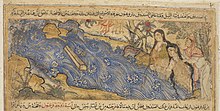
At that place is an unusual depiction in the Edinburgh University Library manuscript of the Jami' al-tawarikh, an aggressive world history written in Persia at the start of the 14th century. In the Qur'an and Islamic tradition, it is Pharaoh'due south married woman, Asiya, who rescues the babe, not his girl. Here the baby Moses remains in his "ark", which is carried forth a river with curling Chinese-style waves towards the women.[64]
The queen is in the river with an attendant, both at to the lowest degree clothed in undergarments (more than wearing apparel seem to exist hanging from a tree branch), and an older servant, or Moses' mother, on the bank. The ark appears enclosed and solid; it looks rather like an elongated coffin, peradventure because the artist was unfamiliar with the discipline. There are few comparable Islamic world histories, and like other scenes in the Jami' al-tawarikh, this may be all only unique in Islamic miniatures. The limerick may be derived from Byzantine depictions.[65]
This manuscript has seven miniatures of the life of Moses, an unprecedented number perhaps suggesting a special identification with Moses by the writer Rashid-al-Din Hamadani, a catechumen from Judaism who became chief minister of Persia.[66]
Leading depictions [edit]
- The Finding of Moses past Gianbattista Tiepolo, in Edinburgh; a unlike limerick in Melbourne.
- The Finding of Moses by Orazio Gentileschi, versions in the Prado, Madrid and National Gallery, London
- The Finding of Moses by Nicolas Poussin; there are iii different compositions, two in the Louvre, Paris, the other National Gallery, London
- The Finding of Moses past Paolo Veronese, various compositions, in the Prado, Dresden, Dijon and elsewhere
- The Finding of Moses by Lawrence Alma-Tadema, 1904, sold at auction in 2010 for nearly Us$36 million. Private collection.
See as well [edit]
- "The Finding of Moses" (poem), a poem by the Irish street poet Zozimus (b. circa 1794 – d. 1846)
Notes [edit]
- ^ This is rarely used in English language, but standard in the Latin languages, eg Moïse sauvé des eaux is the normal title in French.
- ^ Exodus 2, New International Version (NIV); Yavneh, 53–56, analyses the passage and later on interpretations of it at length.
- ^ Vino, 370–371, on the London Poussin; Yavneh, 61, on the Prado Veronese, both disagreeing with other art historians on who figures represent in particular depictions.
- ^ Notation to text equally quoted above
- ^ a b Hall, 213
- ^ Natif, 18, for Byzantine and Islamic examples
- ^ Once again, a rare title in English language, only normal in the Latin languages. Nicolas Poussin painted both scenes more once, and his compositions are described in Edgeless, Anthony, "Poussin Studies 4: Two Rediscovered Late Works", The Burlington Magazine, vol. 92, no. 563, 1950, pp. 39–52., JSTOR
- ^ Ulmer, 297
- ^ Hand p.80; Purtle, 1999, pp 5–6
- ^ Schiller, 50 quoted; Vino, 374, note 31
- ^ Hall, 213; Wine, 369
- ^ Yavneh, lx; Sistine, 51
- ^ Hall, 213; Sistine, 52–56
- ^ Sistine, 43; Hall, 213–216 lists 13 potential scenes.
- ^ Sistine, 40–41, l–75 analyze the paired cycles.
- ^ "WI-ID Subject field Tree". iconographic.warburg.sas.ac.britain.
- ^ One of the single sheets now in the Morgan Library, MS M.0724r.
- ^ Mann, 169–170
- ^ Barmash, Pamela, ii, in Exodus in the Jewish Experience: Echoes and Reverberations, Editors, Pamela Barmash, W. David Nelson, 2015, Lexington Books, ISBN 1498502938, 9781498502931, google books; for Poussin's hippo-hunt see below
- ^ Sistine, 43, 46–47, 51
- ^ Yavneh, 51; Robertson, 100
- ^ 'Paul, Benjamin (2012). Nuns and Reform Art in Early Modern Venice: The Architecture of Santi Cosma east Damiano. p. 244. ISBN9781409411864.
- ^ Yavneh, 53, 58–59
- ^ Bowers, 7–10; both still belong to the London Foundling Hospital; the Hogarth image
- ^ "Web Gallery of Art, searchable fine arts image database". www.wga.hu.
- ^ Wine, 366, 369
- ^ Poussin'southward diverse compositions are described in Blunt, Anthony, "Poussin Studies IV: Two Rediscovered Late Works", The Burlington Magazine, vol. 92, no. 563, 1950, pp. 39–52., JSTOR
- ^ Wine, 374, annotation 29
- ^ DeWitt
- ^ Acts seven:22; Welu, James. "Vermeer'southward Astronomer: Observations on an Open Book", 266, The Art Bulletin, vol. 68, no. 2, 1986, pp. 263–267., JSTOR
- ^ "The finding of Moses: Moses brought before Pharoah's daughter by Bonifazio de' Pitati". www.artgallery.nsw.gov.au.
- ^ Freedburg, 535–536
- ^ Huse, Norbert; Wolters, Wolfgang (1993-x-xxx). The Art of Renaissance Venice: Architecture, Sculpture, and Painting, 1460–1590. p. 270. ISBN978-0226361093.
- ^ Willis, note 7, lists iv, plus 3 from his workshop; Yavneh, 51–53; Robertson, 100
- ^ Yavneh, 51
- ^ Willis, quoted; Robertson, 99–100; The Finding of Moses, after 1740, Probably by Francesco Zugno National Gallery
- ^ Brigstocke, 160; Robertson, 100; the Dresden Veronese
- ^ Willis
- ^ Altogether he painted virtually nineteen works set in Egypt, some x% of his output
- ^ Wine, 369–370
- ^ Wine, 369, 374–375, notes 32, 37, 39
- ^ Bull, 540–541
- ^ Jaffé, David, "Two Bronzes in Poussin's Studies of Antiquities", in The J. Paul Getty Museum Periodical: Book 17, 1989, 45–46, note eighteen, 1990, Getty Publications, ISBN 0892361573, 9780892361571, google books
- ^ Tapestry in the Bizarre: New Aspects of Production and Patronage, Metropolitan Museum of Art symposia, Editors Thomas Patrick Campbell, Elizabeth A. H. Cleland, 96, 2010, Metropolitan Museum of Art, ISBN 030015514X, 9780300155143, google books
- ^ Bull, throughout; Vino, 369
- ^ Thompson, Jason, Wonderful Things: A History of Egyptology 1: From Antiquity to 1881, 255, 2015, The American University in Cairo Press, ISBN 9774165993, 9789774165993, google books
- ^ Tollerton, David, ed., Biblical Reception, 4: A New Hollywood Moses: On the Spectacle and Reception of Exodus: Gods and Kings, 75–77, 2016, Bloomsbury Publishing, 2016, ISBN 0567672336, 9780567672339, google books
- ^ Langston, 47
- ^ Weitzmann, 366–369, 374; Ulmer, 298–304; Mann, 169–170; Langston, 47
- ^ Ulmer, 299
- ^ Mann, 169–172, 183; Ulner, 297 and throughout. For a sceptical view of the links, see Guttmann, 25–26
- ^ Ulmer, 305
- ^ Ulner, 311
- ^ Ulmer, 305; AGK Images
- ^ "Alcestis and Hercules in the Crypt of via Latina", Beverly Berg, Vigiliae Christianae, Vol. 48, No. 3 (Sep., 1994), pp. 219–234, Brill, DOI: 10.2307/1584095, JSTOR
- ^ Ulmer, 304–305
- ^ Mann, 169–172, 183; Ulmer, 303 has a listing in note 26.
- ^ Ulmer, 307; f. 9r, British Library, MS add. 27210, image
- ^ Mann, 170; Ulmer's listing, 303, annotation 26
- ^ Ulner, 322
- ^ Ulner, 312–314
- ^ Ulmer, 215
- ^ DeWitt, fig. 2 and text
- ^ Natif, 17–18; "The infant Musa (Moses) constitute by women of Pharaoh'south household", Edinburgh Academy
- ^ Natif, 17–18
- ^ Natif, 15
References [edit]
- Bowers, Toni, The Politics of Motherhood: British Writing and Civilization, 1680–1760, 1996, Cambridge University Press, ISBN 0521551749, 9780521551748, google books
- Brigstocke, Hugh; Italian and Spanish Paintings in the National Gallery of Scotland, 2d Edn, 1993, National Galleries of Scotland, ISBN 0903598221
- Freedburg, Sidney J. Painting in Italy, 1500–1600, 3rd edn. 1993, Yale, ISBN 0300055870
- Bull, Malcolm. "Notes on Poussin'south Egypt", The Burlington Magazine, vol. 141, no. 1158, 1999, pp. 537–541., JSTOR
- DeWitt, Lloyd. "Finding of Moses, (PG-100)", in The Leiden Collection Catalogue, Arthur Yard. Wheelock Jr., Ed., New York, 2017, spider web page: Finding of Moses, by Pieter de Grebber, Leiden
- Gutmann, Joseph, The Dura Europos Synagogue Paintings and Their Influence on Later on Christian and Jewish Art, Artibus et Historiae, Vol. ix, No. 17 (1988), pp. 25–29, JSTOR, or Complimentary online
- Mitt, J.O., & Wolff, M., Early Netherlandish Painting (catalogue), National Gallery of Art, Washington/Cambridge Upwardly, 1986, ISBN 0-521-34016-0. Entry pp. 75–86, by Mitt.
- Hall, James, Hall's Dictionary of Subjects and Symbols in Fine art, 1996 (2nd edn.), John Murray, ISBN 0719541476
- Langston, Scott One thousand., Exodus Through the Centuries, 2013, John Wiley & Sons, ISBN 111871377X, 9781118713778, google books
- Isle of mann, Vivian B., "Observations on the Biblical Miniatures in Spanish Haggadot", in Exodus in the Jewish Experience: Echoes and Reverberations, Editors, Pamela Barmash, W. David Nelson, 2015, Lexington Books, ISBN 1498502938, 9781498502931, google books
- Natif, Mikah, "Rashid al-Din'due south Alter Ego: The Seven Paintings of Moses in the Jami al-Tawarikh", in Rashid al-Din. Agent and Mediator of Cultural Exchanges in Ilkhanid Iran, 2013, online text, academia.edu
- Purtle, Carol J, The Fine art Bulletin, March 1999, "Van Eyck's Washington 'Annunciation': narrative time and metaphoric tradition", Vol. 81, No. 1 (Mar., 1999), pp. 117–125. Folio references are to online version, no longer bachelor (was hither), JSTOR
- Robertson, Giles. "Tiepolo'south and Veronese's Finding of Moses", The Burlington Magazine, vol. 91, no. 553, 1949, pp. 99–101., JSTOR
- Schiller, Gertrude Iconography of Christian Art, Vol. I,1971 (English trans from German), Lund Humphries, London, pp 33–52 & figs 66–124, ISBN 0-85331-270-2
- "Sistine": Pietrangeli, Carlo, et al., The Sistine Chapel: The Art, the History, and the Restoration, 1986, Harmony Books/Nippon Television, ISBN 0-517-56274-Ten
- Ulmer, Rivka, Egyptian Cultural Icons in Midrash, Affiliate 10, "The Finding of Moses in Art and Text", 2009, Walter de Gruyter, ISBN 3110223929, 9783110223927, google books
- Weitzmann, Kurt, ed., Historic period of spirituality: late antique and early on Christian fine art, third to seventh century, no. 149, 1979, Metropolitan Museum of Fine art, New York, ISBN 9780870991790; full text available online from The Metropolitan Museum of Fine art Libraries
- Willis, Zoe, "The Melbourne Finding of Moses: Steps towards a New Attribution", 2008 Art Bulletin of Victoria, No. 48, National Gallery of Victoria (by 2017 this painting was attributed to Tiepolo)
- Vino, Humphrey, National Gallery Catalogues (new series): The Seventeenth Century French Paintings, 2001, National Gallery Publications Ltd, ISBN 185709283X
- Yavneh, Naomi, "Lost and Found; Veronese'due south Finding of Moses", Chapter three in Gender and Early on Modern Constructions of Childhood, 2016, Eds. Naomi J. Miller, Naomi Yavneh, Routledge, ISBN 1351934848, 9781351934848, google books and google books – ebook, with different pages viewable
External links [edit]
-
 Media related to Finding of Moses at Wikimedia Commons
Media related to Finding of Moses at Wikimedia Commons
saunderstimperelligy81.blogspot.com
Source: https://en.wikipedia.org/wiki/Finding_of_Moses
0 Response to "Pictures of Moses as a Baby and as Pharoh's Son"
Post a Comment